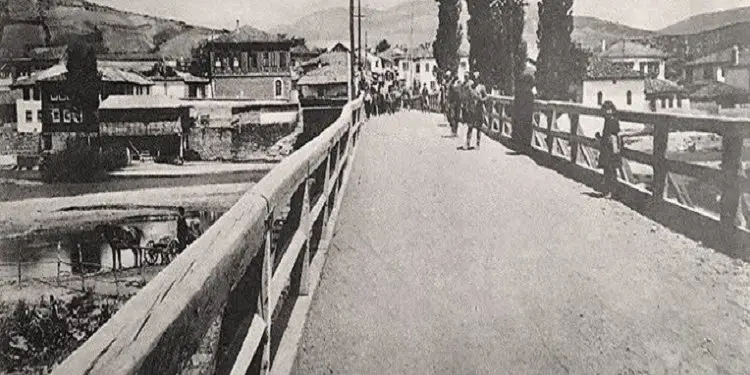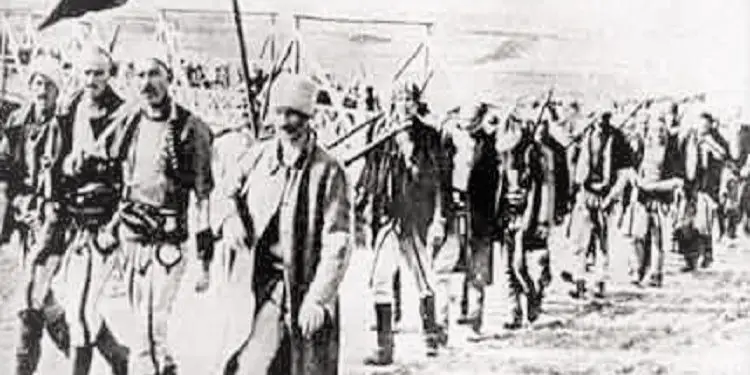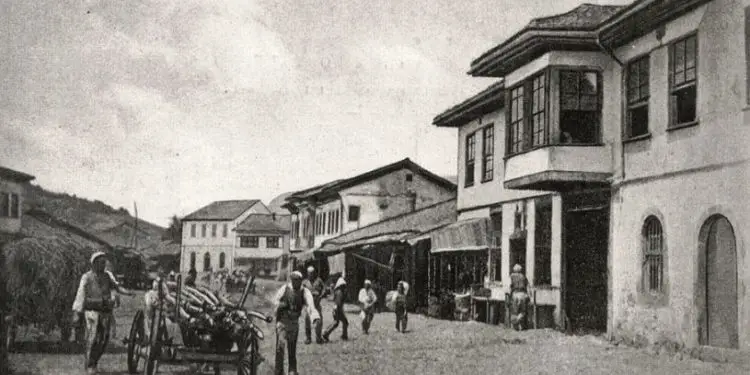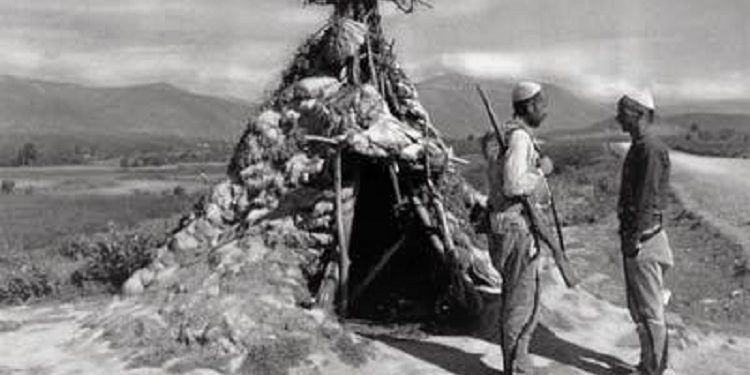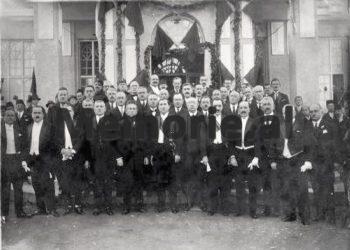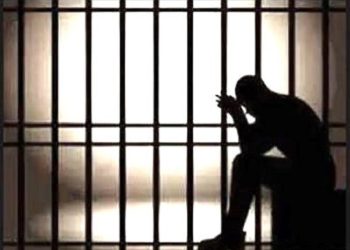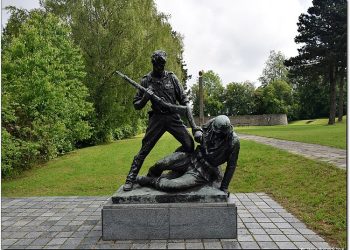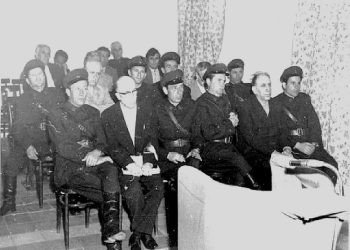From Bashkim Trenova
Part seventeen
MYTH-MYSTICISM, VICTIMOMANIA, RACISM AND SERBONOSTALGIA
ALBANIANS ACCORDING TO THE SERBS
(THE EASTERN CRISIS AND THE BALKAN WARS)
Memorie.al / “Serbs are descended from the Slavs, a large number of tribes who gave life to the Slavic peoples. Knowledge about the origins of the history of the Slavs is modest and not so clear. Their name appears for the first time in the 6th century AD, when Byzantine writers start talking about the Slavs….”! (Dushan Bataković, Milan St. Protic, Nikola Samardžić, Aleksandër Fotic. History of the Serbian People. L’Age d’Homme. Lausanne. 2005. Pg. 3.)
Continues from last issue
Jovan Cvijič – geographer, president of the Royal Serbian Academy, professor and rector of the University of Belgrade:
At a distance from the motherland (nearly 200 km.) were the oases of Arban in the west of Leskovci, then in Masurica, north of Vranje and in Peshter, near Senica. These Albanian settlements are marked on all old maps, and in fact they existed until 1878. As Serbia at this time took the region of South Moravia, the Albanians moved, mainly to the Llap Valley, to Kosovo and Metohija and so strengthened the Albanian population there. In the vicinity of Leskovci and Vranje, there are no more Albanian oases, at the time of the Serbian-Turkish wars, 1876-1878, Albanian lands and settlements extended to Kopanik, Prokuplje, Leskovc, Surdulicë, Vranje, Mali Rujan, but also to Nis , in the district of Prokuplje and Dobrica.
In Prokuplje, towards Nishi, there were these settlements: Novo Sella, Lower and Upper Devca, Klisurica, Xhigola and Kordnica. In the district of Dobrica were the following Arnaut settlements: Lukomir, Vllahova, Lugina e Veternica, Toplica, Medvegja, Pusta Reka and Jabllanica. Then in Masurica, the villages: Zhitoragja, Masurica, Suvojnica, Allakinca, Dekutinca, Surdulica and others. (2)
—
According to some Serbian archival data (AS), it is said, among other things, that: “During the Serbian-Turkish wars of 1877-1878, the Serbian army, following the order of the general staff and the Serbian government, forcibly moved from Toplica, Leskovci, (Nishi), killing more than 30,000 Albanians”. (1)
Albanian houses were colonized with Serbian, but also Montenegrin, population. Safet Pasha and an English deputy had promised the return of the Albanian population. In return, the Russian deputy in Istanbul was allegedly engaged, just so that the Serbian government does not receive criticism from the European powers. Albanians who moved from Serbia mostly settled in Kazan, Pristina, Gjilan, Vushtria and Presheva, but they also reached Prilep and Prizren”. (3)
1 – Ivo Andric. Project for the occupation and partition of Albania between Yugoslavia and Italy, presented to the Yugoslav government in January 1939. Le Monde 28 avril 2005 -I vo Andriç, romancier engagé. This project was made known in 1977 by the Croatian magazine Casopis za suverumen povijest (Journal of contemporary history), Zagreb, 9 (1997) 2. Pg. 78-89.
2 – Jovan Cvijič, Balkansko poluostrvo, knj. 2, Belgrade, 2000. Pg. 189.
****
Jovan Haxhi Vasiljevic – historian, ethnographer and publicist:
1 – Jovan Cvijič, Osnovi za geografiju i geologiju Macedonia i Stare Srbije I-III. (Basics of geography and geology of Macedonia and Old Serbia I-III). Belgrade, 1906-1911.
2 – Jovan Haxhi Vasiljevic, Arnautski pokreti in the 19th century. (Albanian movements in the 19th century). Belgrade, 1905. Pp. 6.
3 -Jovan Haxhi Vasiljevic, ARBANASKA LIGA: Arnautska Kongra I Srpski narod u turskom Carstvu (1878-1882). The Arnaut Congress and the Serbian people in the Turkish Empire. Belgrade, 1909. Pp. 2.
—
“Before the war in question; 1877-1878, only in the district of Prokuplja there were 2054 Albanian houses and 2031 Serbian houses, while in the district of Kurshumli there were 1539 Albanian houses and 638 Serbian houses. Meanwhile, Veternica at that time was counted in Arnautllek. (1)
****
Kosta Novakovic – one of the most prominent in Serbian leftist politics of the 20th century, editor of Radnicke novine, Radnik and Borba newspapers:
Before Saint Dhimtri, on 25.10.1912, the entire division of Shumadia was gathered in Prizren. We stayed two days…to relax. People walked barefoot through the slush and lay down wet in the old Turkish barracks, half-ruined, huddled together to keep warm. From now on, the diseases of the legs and stomach have started; whole companies of the regiment went every morning for medical aid.
-Where are we going now? – Everyone asked when we arrived in Prizren. The day after the arrival there was talk of going to sea, while the order came the day after.
Detachments are being created, which will go one after the other towards the sea. The army commander received the order to immediately launch the first detachment. People had no shoes, thick clothes, socks, there was not even bread. It must be started – said the order – and this is the main thing. All the rest are secondary matters.
Overwhelmed by dysentery, which did not spare a single soldier out of the 2,500 pale as ghosts, we set out to invade Albania and “give water to the horses in the sea”! I could not forgive the Supreme Command and our government for this adventure of theirs, which cost us so many lives; I cannot forgive the doctors, who sent the mass of rheumatism, tuberculosis and infirm patients to leave their bones in Albania.
1- Jovan Haxhi Vasiljevic. “Arnauti naše krvi-Arnautaši.” (“Arnauts of our blood-Arnautashes”) Belgrade, 1939.
The battalion commanders were not allowed to go “to sea” and decided by lot which battalion would go first. Perhaps under the example of their superiors, who threw the dice, NCOs and company commanders cashed in on the march to the sea? They took 2-3, even 5-6 dinars from the soldiers for not putting them on the lists of those who would go to sea.
We spent the night in the village of Brut. A small, beautiful village, which was burnt and ruined. There were people in two half-ruined houses, the others were deserted. The next day we again follow the river Drin, along the road of the Vezir Bridge… Near the bridge we met our patrol, 9 graves of our soldiers and 9 severed heads of Arnauts on their graves. The patrol on the bridge tells us about the revenge. They had ordered the villagers of the neighboring villages to bring them food, and when they came, they killed them and cut off their heads. The heads were then placed at the feet of the slain soldiers, as they should be: slaves at the feet of their owners!
We passed Drin. A desert Arnaut came across a whole flock of sheep by the road, and when he tried to protect the sheep from being taken by the army, he was killed and the sheep taken away. Both men and women were convinced that it was not possible for us to go as conquerors to subjugate them, but that we are going to fight with the Turkish army, which they also hate. Therefore, the Albanian population helped the hungry and exhausted Serbian soldiers at first.
The positive thing that the Serbian army created for the Albanian people is the unanimous resistance and hostility towards Serbia. What can unite all Albanians now, especially after the recent uprising of Arnauts and the attack against Serbia, is the enmity against the latter. The fact is painful, but the fact that it exists is not the fault of the Albanians. The fear of losing their independence is an important factor, and this will surely soon lead to the only right way to protect themselves from external enemies, in a stronger union, in a state form.
After arriving in Albania, for the Serbian army there was no longer a question whether Albania would be Serbian or not. She quickly solved it…The army thought it was ours and should remain so…At that time you had only one problem to concern yourself with: how the troops will be supplied; to take appropriate measures for the bloody suppression of any grievance, no matter how small; not to spare any man who tries, even for isolated resistance to the Serbian authorities, and to burn the whole village if even a single shot is heard.
And the military regime reigned with all its bad sides. Its enforcers were non-commissioned officers and officers with a barracks mentality, people with too narrow a horizon and few moral concepts destroyed; without scruples towards people of foreign nationality, without criteria of what should and what should not. The first and most necessary thing for the administration of the military command in Albania was considered the tripod and the fear of death.
The military commanders did not try to invent any method of solving the problems, when they had one: murder. They were not responsible for this, as it was a war. If someone “makes a mistake”, kill them so that they don’t make mistakes again, so that it is not he who makes amends, but the other. Let fear rule, let everything tremble before them, this was the main principle of most commanders.
When it comes to the commander of the Kruja garrison, we must mention that there were many death sentences carried out by shooting, but especially by hanging. There is no greater shame for an Albanian than slapping him in the face or beating him in public, and there is no lower death than hanging. The frequent hangings in Kruja had a very bad effect on the population of Kruja and its surroundings, even in Mat.
And when the commander of Kruja once sent a platoon of soldiers with an officer to set fire to the houses of some Arnauts, who with weapons in hand left the houses and went to Mat before our arrival, the Arnauts attacked the platoon and completely routed it. The platoon returned to Kruja only after 2-3 days after suffering a lot of losses.
There were cases when people returned to their homes and surrendered their weapons, after being told that nothing would happen to them, but they suffered very badly. They were hanged or shot. For others, this served as an example and they did not give up anymore… This especially affected the tribe of Mati, who decided for a while for peace… Mati remained armed throughout our stay in Albania, ready to repulse the attack of the Serbian army against him. He did not trust the Serbian army, there was nothing left in Albania to speak of the position of the Serbs, except for the graves, many graves scattered throughout all the places they trampled.
Albania remained what it had been, a country that suffers from its own internal diseases and from its external “friends”.
I am only mentioning Peqin near the river Shkumbin, where our commies ruled for some time. Because of a small skirmish in front of Peqin, before they took it, and because of 6 soldier commies killed, several hundred Albanians were killed. Although these soldiers were killed in the fight, each of these “knights” considered it their duty to avenge their slain comrades, and this by killing and slaughtering many Arnauts.
1 – Kosta Novakovic. Četiri meceta u middle Albania. (Four months in Central Albania). Borba. Book 7. 1914.
At the beginning of April 1913 I was in Durrës (Albania) when the Serbian soldiers boarded the ship and left for Serbia. Albanian children ran behind the columns of Serbian soldiers, singing the famous national song: “We are not Serbs, nor Bulgarians, we are brave Albanians”. The children had put the word “Serbian” instead of the word “Greek”. The Serbian peasants, who made up the Serbian army, returned home smiling because the expedition against Albania, an expedition they did not understand, was finally over.
The insults of the Albanian children did not bother them at all, because they knew they deserved them; these songs certainly did not take revenge for the terrible barbarism they had exercised against the Albanian people during the six months of the occupation. But behind the Serbian peasants, exhausted by the war and diseases, was the official Serbia, which clenched its teeth indignantly, because it had been forced by the ultimatum of the great powers to abandon Albania.
War operations were long over. The invasion of Albania by the Serbian army had been a Serbian imperialist attempt to occupy the ports of Shkodra, Durrës and Shengjin. But, even though the Pan-Serbian imperialists would leave Albania, the conquest of Shkodra and Northern Albania remains one of the main points of the imperialist program. The Serbian manual “What should I know as a soldier?” for the education of soldiers, approved and recommended by the Ministry of War with the decree of IP no. 1161, dated August 23, 1922, includes this sentence: “All our provinces. Shkodra and a part of Northern Albania have not yet joined our Kingdom…! Peasant Serbia no longer exists.
It gradually lost its importance over several decades and disappeared completely in 1912. In its place emerged an imperialist Serbia, with pan-Serbian imperialists, pan-Serbian dynasty and pan-Serbian militarism. This rude, brutal and cruel new imperialism dreams of restoring the empire of King Stefan Dušan and tries to cross in 10 years the path followed by the imperialist powers that have existed for centuries. The Serbian peasant was a blind tool of pan-Serbian imperialism, meat for cannon, an animal without a tail, as the Serbian officers called him.
He was forced by the whips of the officers to throw himself headlong into the fire and burn and destroy the places that were occupied. During the invasion, the Serbian imperialist government spared no effort against the Albanians. It massacred, killed and looted the poor Albanian population. And she persecuted only the poor. The first victims of Serbian imperialism were Macedonia and Kosovo. And although they were forced by other, more powerful imperialists to leave the shores of Albania, the Pan-Serbian imperialists reserved for themselves the most fertile territory – Kosovo. The region inhabited by Albanians is called Kosovo: the plain of Kosovo, Metohija and the southern part of old Sanxhak up to Novi Pazar.
More than 500,000 Albanians became slaves of the new invaders. In addition to these, there are 150,000–200,000 Albanians in Macedonia, which means that there are 650,000–700,000 Albanians in Yugoslavia. Captive Kosovo is an exemplary case of extreme oppression of a nation during the Balkan Wars and the First World War. The wild, terrorist and inquisitorial measures used in Kosovo have not been observed either in eastern Ukraine or Belarus under Poland, nor in Bessarabia or Dobruja under Romania… In this respect, only Macedonia can be compared with Kosovo. When they invaded Kosovo, the Serbian imperialists announced that they were reclaiming the historical rights they had in 1389 (before the Battle of Kosovo).
On the basis of similar “historical rights”, Italy or France, Greece or Turkey can now rise to claim half of Europe, having owned parts of it in the past. So France can claim a part of Russia, as Napoleon once did in Moscow in 1812. But Serbia’s “historical rights” over Kosovo are even more surprising. When the Turkish army in the middle Ages reached the borders of Austria, the Serbian patriarch Arsenije Crnojevic and the Serbian landlords went to fight for Austria and protect the Danube and Sava rivers. The patriarch and the landowners took with them 170,000 families from Kosovo, mostly bachelors and young servants, and settled them in Banat and Backa, which Austria gave them.
Now, hundreds of years later, the pan-Serbian imperialists claim that they have “historical rights” both in Backa and Banat, where the Kosovo Serbs were settled and in Kosovo from where they left. And this is what they call historical justice! On the basis of these “historical rights” the Pan-Serbian imperialists want to take “Pan-Serbo Kosovo” without Serbs. Kosovo is a completely Albanian territory; there are only 10 to 15% Serbs. Serbian imperialists used the tactics and methods of medieval warriors or colonial conquerors: annihilation of the population under the pretext of military operations, disarmament of the population and suppression of armed resistance.
Thus, in the years 1912-1913, 120,000 Albanians, men, women, elderly and children, were deported; hundreds of villages, mostly in Kosovo and less in Macedonia, were bombed and most of them were completely destroyed. It should be noted that the representative of the imperialist policy of Tsarist Russia, Hartwig, the Russian Minister in Belgrade, blessed the policy of annihilation practiced by Belgrade. The Russian Orthodox Tsar asked his Orthodox brothers, King Peter and his son Alexander, to kill an entire people and spread the Orthodox faith in the Balkans. At least 50,000 Albanians were forced to become refugees and flee to Turkey and Albania for their lives.
This annihilation reduced the presence of the Albanian nation in Kosovo, but in no way changed its Albanian character. The purpose of these massacres against Albanians in Kosovo was to replace them with Serbs, to colonize and preserve it. However, until the end of 1912, when there was resistance from the Albanians, the colonization continued rather slowly. Only a few Serbs settled in the Kosovo region at first. Here we are giving some official statistics of the Serbian government, which show the Albanian character of Kosovo. In the district of Prizren, in 1921, there were 17% Serbs; the percentage was the same in the districts of Pristina, Mitrovica, Gjilan, Peja and Gjakova. In some other areas there were even fewer Serbs.
In 1921, all of Kosovo had at most 17% Serbs. The Albanian national stance was developed in two lines: in the legal line, through the Muslim organization Xhemijet, and in the revolutionary line, through the armed struggle organized by the Albanian national guerilla fighters called kaçaka. We will talk about Xemijet later. The Serbian government tried to label the Albanian Kachaks as thugs and gave government agents and any Serbian fascists the right to kill them. In reality, the Kaçaks are not thieves at all, but rebellious Albanian patriots. They abandoned everything, their homes and possessions, taking the road to the mountains; formed Chetas [guerilla units, term from which comes the Serbian/Bulgarian/Macedonian term “Chetnik”, originally neutral, today equal to “terrorists” – SAS] with freedom fighters and fight against the injustices and barbaric acts of the Serbian army and police .
The freedom fighters are thus convinced that they can expel the Serbian regime from Kosovo. These national fighters fought a tenacious fight, a fight that must be appreciated, against the much larger forces of the Serbian gendarmerie and army. The names of Bajram Curri, Azem Bejta and hundreds of other brave warriors, who fell martyrs in this war, remain engraved in the hearts of Kosovo Albanians. Only in the district of Llap there were 2000. In 1920, at the time of the uprising of Llap, the Serbian army, under the command of Colonel Radovan Radovic, bombed the large village of Prapashtica and left not a single house standing.
As in the district of Llap, Albanian national movements arose in many other parts of Kosovo, and large deployments of Serbian forces succeeded in suppressing them in 1919 and 1924. Here we mention the uprisings of Plava, Gucia and Rugova in 1919, that of Pristina in 1921, that of Drenica in 1923, that of Mitrovica in 1924 and that of Drenica in 1924. In suppressing these rebellions, the Serbian army killed 2,600 Albanians. Thus, national resistance was limited to the actions of guerilla units of freedom fighters. According to an official Serbian government report, 1,200 patriots were organized into guerrilla units in 1924.
In 1927, the Serbian police took stock: 310 Albanian insurgents were killed [I think this figure is not correct, it is too low – SAS], 175 were captured and 626 surrendered. In 1927 the freedom fighters stopped acting, but their spirit lives in every village and will not die until Kosovo is free. The Serbian regime knows this well. As a result, he decided to completely denationalize Kosovo, brutally suppressing the resistance of the Albanians and, in particular, taking their lands and colonizing them with Serbs. (1) Memorie.al
1 – Kosta Novakovic. The colonization and serbization of Kosovo. (Colonization and Serbization of Kosovo). National Liberation (Libération nationale), Geneva, July 13, 1931.
The next issue follows





